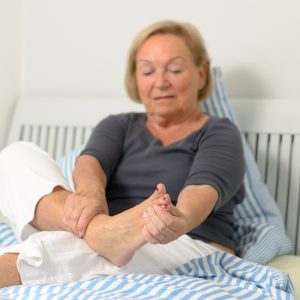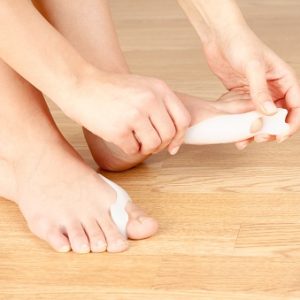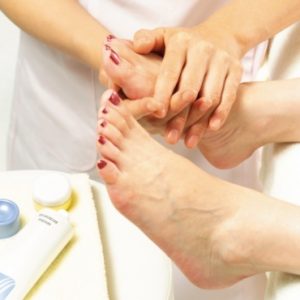Dr. Brian Nagy | April 5th, 2018
Posted In: Bunions
 You might feel that as you get older you develop new and different aches and pains every day. Throughout your life, you’ve stood on your feet, walked, and ran and they’ve supported your whole body every day. This continued pressure and stress can cause painful foot conditions, like bunions to develop. You might think that […]
You might feel that as you get older you develop new and different aches and pains every day. Throughout your life, you’ve stood on your feet, walked, and ran and they’ve supported your whole body every day. This continued pressure and stress can cause painful foot conditions, like bunions to develop. You might think that […]
Dr. Brian Nagy | March 13th, 2018
 In some cases, bunion surgery is not only safe for children but recommended. Many adults who get bunions can think back to a time when they were younger that they experienced foot problems or pain. This is because the main cause of juvenile bunions is heredity; bunions in children do not tend to go away on their own […]
In some cases, bunion surgery is not only safe for children but recommended. Many adults who get bunions can think back to a time when they were younger that they experienced foot problems or pain. This is because the main cause of juvenile bunions is heredity; bunions in children do not tend to go away on their own […]
Dr. Brian Nagy | February 15th, 2018
Posted In: Bunions
 Bunions are a common foot problem in adults and can often appear as you age. Although bunions aren’t as common in children, bunions can begin to appear early on if the wrong size shoes are worn. Bunions may also appear if you receive an injury to your foot that results in structural abnormalities. The right […]
Bunions are a common foot problem in adults and can often appear as you age. Although bunions aren’t as common in children, bunions can begin to appear early on if the wrong size shoes are worn. Bunions may also appear if you receive an injury to your foot that results in structural abnormalities. The right […]
Dr. Brian Nagy | December 29th, 2017
Posted In: Bunions
 If you’re suffering from a painful bony bump on the side of your toe, you might have a bunion. Additional symptoms include swelling, redness, restricted movement of your toe, corns, and calluses. Perhaps you’re experiencing bunion pain for the first time, but it’s possible that you’re prone to getting bunions on a recurring basis. If your […]
If you’re suffering from a painful bony bump on the side of your toe, you might have a bunion. Additional symptoms include swelling, redness, restricted movement of your toe, corns, and calluses. Perhaps you’re experiencing bunion pain for the first time, but it’s possible that you’re prone to getting bunions on a recurring basis. If your […]
Dr. Brian Nagy | November 20th, 2017
Posted In: Bunions
 Bunions are bumpy protrusions that develop near the base joint of the big toe. They can be extremely painful and make your shoes fit improperly. A bunion forms when the joint of the big toe is forced out of position. This commonly occurs when the big toe is pressed into the neighboring toe for long […]
Bunions are bumpy protrusions that develop near the base joint of the big toe. They can be extremely painful and make your shoes fit improperly. A bunion forms when the joint of the big toe is forced out of position. This commonly occurs when the big toe is pressed into the neighboring toe for long […]
Dr. Brian Nagy | November 3rd, 2017
Posted In: Bunions, General Foot Care
 Bunions are ugly and cause foot pain, potentially leading to trouble walking or even standing. Bunions are bony bumps that form on the sides of your feet where your big toe joins the rest of the foot. Bunions sometimes also form on the outer edge of your foot where your pinkie toe joins your foot. […]
Bunions are ugly and cause foot pain, potentially leading to trouble walking or even standing. Bunions are bony bumps that form on the sides of your feet where your big toe joins the rest of the foot. Bunions sometimes also form on the outer edge of your foot where your pinkie toe joins your foot. […]
Dr. Brian Nagy | October 17th, 2017
Posted In: Bunions
 Bunions are a common foot disorder, with 23% of Americans over the age of 18 and 36% over the age of 65 living with painful bony bumps on the joint between their big toe and the rest of their foot. In many cases, you can take care of your feet with some minor lifestyle adjustments and […]
Bunions are a common foot disorder, with 23% of Americans over the age of 18 and 36% over the age of 65 living with painful bony bumps on the joint between their big toe and the rest of their foot. In many cases, you can take care of your feet with some minor lifestyle adjustments and […]
Dr. Brian Nagy | September 19th, 2017
Posted In: Bunions
 Do you suffer from bunion pain? A bunion is a bump that forms on the outside of your foot at the base of your big toe. When the bump forms on the side of your little toe it is called a bunionette. These unsightly deformities develop gradually when your foot is out of alignment or your toe joint […]
Do you suffer from bunion pain? A bunion is a bump that forms on the outside of your foot at the base of your big toe. When the bump forms on the side of your little toe it is called a bunionette. These unsightly deformities develop gradually when your foot is out of alignment or your toe joint […]
Dr. Brian Nagy | August 25th, 2017
 Are you a runner who’s suffering from bunions? Whether you’re an elite runner or just training for a specific race or two, you know the benefits that running offers. It can be a great way to get the exercise you need, keep you connected to friends who also run, improve your cardiovascular health, and make […]
Are you a runner who’s suffering from bunions? Whether you’re an elite runner or just training for a specific race or two, you know the benefits that running offers. It can be a great way to get the exercise you need, keep you connected to friends who also run, improve your cardiovascular health, and make […]
Dr. Brian Nagy | August 16th, 2017
Posted In: Bunions, Foot Surgery
 Bunions often develop slowly and many people put off treatment until their bunion either causes them pain or their deformity becomes so large it prevents them from wearing normal shoes. Like most medical conditions, bunions are easily managed when diagnosed in an early stage, when treatment can be less invasive. However, in some cases, when the […]
Bunions often develop slowly and many people put off treatment until their bunion either causes them pain or their deformity becomes so large it prevents them from wearing normal shoes. Like most medical conditions, bunions are easily managed when diagnosed in an early stage, when treatment can be less invasive. However, in some cases, when the […]